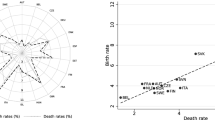Abstract
This paper investigates the validity of Gibrat’s Law holding for firms in manufacturing and retail trade sectors. The object is to expand our knowledge of Gibrat’s Law to include non-manufacturing firms. A unique longitudinal firm-level database, which contains information on Canadian incorporated establishments, enables the inter-industry comparison. The findings of the analysis are that Gibrat’s Law is violated in both manufacturing and retail sectors. Violations of Gibrat’s Law for both sectors include (i) growth rates that depend on firm size (ii) growth variability that depends on firm size and (iii) a negative persistence of firm growth. Finally, age effects or selection effects are not the causes of these violations.
Similar content being viewed by others
References
Almus M., Nerlinger E. A. (2000) ‚Testing Gibrat’s Law for Young Firms – Empirical Results from West Germany’. Small Business Economics 15(1):1–12.
Audretsch D. B., Santarelli E., Vivarelli M. (1999) ‚Start-up Size and Industrial Dynamics: Some Evidence from Italian Manufacturing’. International Journal of Industrial Economics 17(7):965–983.
Audretsch D. B., Klomp L., Santarelli E., Thurik A. R. (2004) ‚Gibrat’s Law Are Services Different?’ Review of Industrial Organization 24(3):301–324.
Caves R. E. (1998) ‚Industrial Organization and New Findings on the Turnover and Mobility of Firms’. Journal of Economic Literature 36(4):1947–1983.
Chesher A. (1979) ‚Testing the Law of Proportionate Effect’, Journal of Industrial Economics 27(4):403–411.
Clark J. S., Fulton M. E., Brown D. J. (1992) ‚Gibrat’s Law and Farm Growth in Canada’, Canadian Journal of Agricultural Economics 40(1):55–70.
Contini B., Revelli R. (1989) ‚The Relationship between Firms Growth and Labor Demand’. Small Business Economics 1:309–314.
Dunne P., Hughes A. (1994) ‚Age, Size, Growth and Survival: UK Companies in the 1980s’. Journal of Industrial Economics 42(2):115–140.
Dunne T., Roberts M., Samuelson L. (1988) ‚Patterns of Firm Entry and Exit in U.S. Manufacturing Industries’. RAND Journal of Economics 19(4):495–515.
Dunne T., Roberts M., Samuelson L. (1989) ‚The Growth and Failure of US Manufacturing Plants’. Quarterly Journal of Economics 96(4):671–698.
Evans D. (1987a) ‚Tests of Alternative Theories of Firm Growth’. Journal of Political Economy 95(4), 657–674.
Evans D. (1987b) ‚The Relationship between Firm Growth, Size, and Age: Estimates for 100 Manufacturing Industries’. Journal of Industrial Economics 35(4):657–674.
Fotopoulos G., Louri H. (2004) ‚Firm Growth and FDI: Are Multinationals Stimulating Local Industrial Development?’ Journal of Industry, Competition and Trade 4(3):163–189.
Gibrat Robert (1931) Les Inegalites Economiques. Paris: Librairie du Recueil Sirey.
Hall B. H. (1987) ‚The Relationship Between Firm Size and Firm Growth in the US Manufacturing Sector’. Journal of Industrial Economics 35(4), 583-606.
Hamilton O., Shapiro D., Vining A. (2002) ‚The growth patterns of Canadian high-tech firms’. International Journal of Technology Management 24(4):458–472.
Hart P. E., Prais S. J. (1956) ‚The Analysis of Business Concentration: A Statistical Approach’. Journal of the Royal Statistical Society 119(Series A):150–190.
Hart P. E., Oulton N. (1999) ‚Gibrat, Galton, and Job Generation’. International Journal of the Economics of Business 6:149–164.
Jovanovic B. (1982) ‚Selection and the Evolution of Industry’. Econometrica 50(3):642–670.
Kumar M. S. (1985) ‚Growth, Acquisition Activity and Firm Size: Evidence from the United Kingdom’. Journal of Industrial Economics 33(3):327–338.
Lotti F., Santarelli E., Vivarelli M. (2003) ‚Does Gibrat’s Law Hold Among Young, Small Firms?’ Journal of Evolutionary Economics 13:213–235.
Mansfield E. (1962) ‚Entry, Gibrat’s Law, Innovation, and the Growth of Firms’. American Economic Review 52(5):1023–1051.
Phillips B. D., Kirchhoff B. A. (1989), ‚Formation, Growth and Survival: Small Firm Dynamics in the US Economy’. Small Business Economics 1:65–74.
Rencher A. C. (2002) Methods of Multivariate Analysis. 2nd edn., New York: J. Wiley.
Shapiro D., Bollman R. D., Ehrensaft P. (1987) ‚Farm Size and Growth in Canada’. American Journal of Agricultural Economics 69(2):477–483.
Singh A., Whittington G. (1975) ‚The Size and Growth of Firms’. Review of Economic Studies 42(1):15–26.
Sutton J. (1997) ‚Gibrat’s Legacy’. Journal of Economic Literature 35(1):40–59.
Tschoegl A. E. (1983) “Size, Growth, and Transnationality Among the World’s Largest Banks.” The Journal of Business 56(2):187–201.
Wagner Joachim (1994) ‚The Post-Entry Performance of New Small Firms in German Manufacturing Industries’. Journal of Industrial Economics 42(2):141–154.
Wooldridge J. (2002) Econometric Analysis of Cross Section and Panel Data. Cambridge: The MIT Press.
Acknowledgements
I thank David Green, Ken Hendricks, George Kondor, John Spraggon, the editor and two anonymous referees, as well as seminar participants at Lakehead University and the empirical microeconomics lunch workshop at UBC for very helpful comments and discussions. I am especially grateful to Garnett Picot and the BLMA division of Statistics Canada for access to the T2LEAP data and their gracious hospitality. I acknowledge the financial support provided by SSHRC (MCRI grant 412–98-0025). All remaining errors are the author’s.
Author information
Authors and Affiliations
Corresponding author
Rights and permissions
About this article
Cite this article
Petrunia, R. Does Gibrat’s Law Hold? Evidence from Canadian Retail and Manufacturing Firms. Small Bus Econ 30, 201–214 (2008). https://doi.org/10.1007/s11187-006-9042-x
Received:
Accepted:
Published:
Issue Date:
DOI: https://doi.org/10.1007/s11187-006-9042-x




